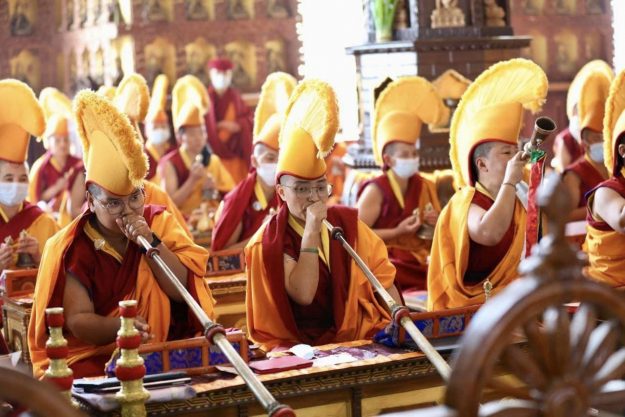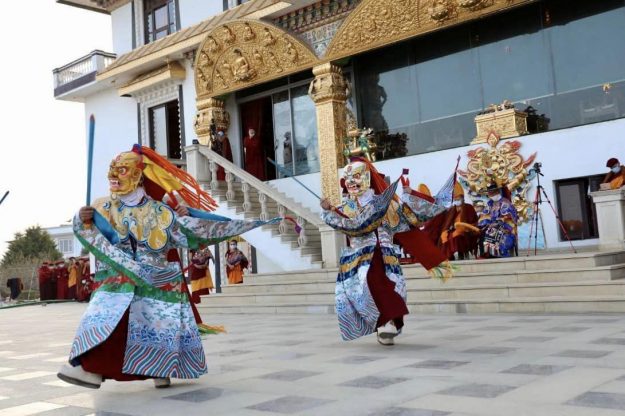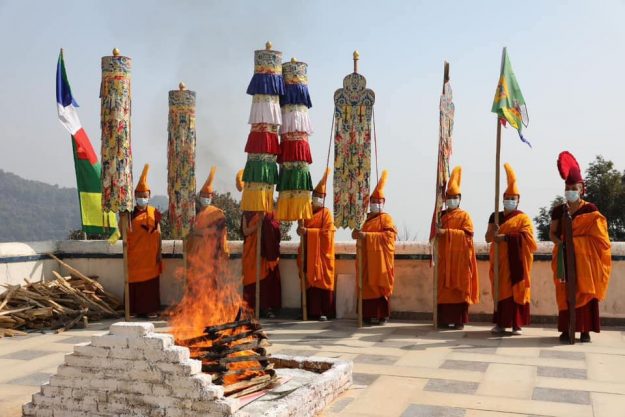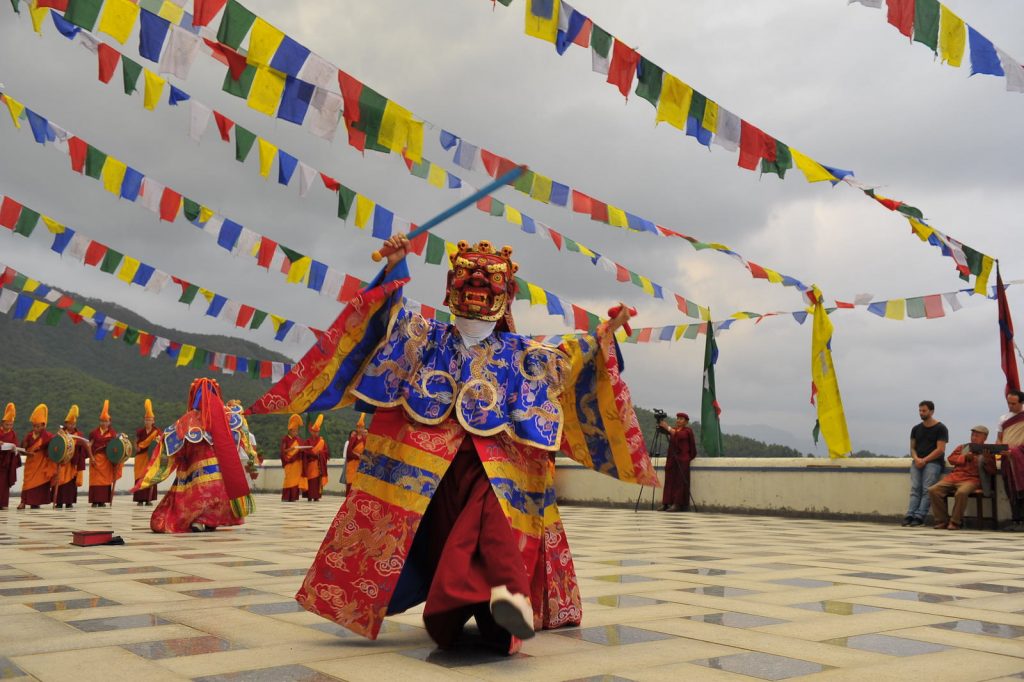Losar, the Tibetan New Year, is a time of great significance for Tibetans and other Himalayan communities in the region and in the diaspora. In the buildup to, celebration of, and weeks following the new moon, monastic centers in the Himalayas perform a host of religious activities to usher in the new year. The purification rituals, which take place before Losar, cleanse the environment of obstacles for the coming year. Losar then begins the auspicious month of Chöthrul Dawa (Miracle Month)—a month when the Buddha performed many marvels. During this time, when all meritorious activities are believed to be multiplied one-hundred-fold, another round of intensive spiritual practices commence to renew intentions for wisdom, compassion, and world harmony. Druk Amitabha Mountain is home to the Drukpa Kagyu (Dragon lineage) nuns, as well as their annual Avalokiteshvara Drupchen, which they commence just after Losar to set the tone for the new year.
Drupchen means “great accomplishment,” and it refers to an intensive group practice dedicated to the energy and quality of a Buddhist deity. The Avalokiteshvara Drupchen involves thirteen-to-sixteen-hour periods of practice across nine days. The rituals integrate numerous elements: cham (sacred dance), sacred instrumental ensembles, an exorcistic rite, sand mandala construction, visualization, mantra recitation, a fire offering, and more. It is literally a performance of Avalokiteshvara’s sacred realm─suffused with drama and visual detail.
While female practitioners have traditionally been denied participation in cham dance, sand mandala construction, leadership roles, and advanced practices (like drupchens), this began to change with the Drukpa nuns. For over twenty years, the nuns have engaged in advanced worship and ritual activities that are still uncommon for women in other Himalayan monastic communities. Jigmet Pema Wangchen (His Holiness the 12th Gyalwang Drukpa, the spiritual leader of the Drukpa lineage) has been a pivotal agent to this change, creating conditions to support the Drukpa nuns as well as advocating for gender equality in Himalayan communities beyond his monastic institutions. To this end, the Drukpa nuns engage in rigorous martial arts training, offering demonstrations of their practice and women’s self-defense workshops. However, beyond their popular moniker of “the Kung Fu nuns,” they are first and foremost highly trained Vajrayana practitioners.
The Avalokiteshvara Drupchen is a nine-day immersive ceremony where practitioners are surrounded by every form and articulation of compassion, as a support to generate oneself as an expression of Avalokiteshvara. To help us understand the background and important features of this grand drupchen, Tricycle talked with Drukpa nun, teacher of philosophy, and cham master Lopön Jigme Tingdzin Zangmo about the history and ritual elements of the Avalokiteshvara Drupchen.
****
What is the meaning and overarching goal of the Avalokiteshvara Drupchen? The main goal is to generate great compassion and work toward the realization of emptiness. In English, we call it the Avalokiteshvara Drupchen. But in Tibetan, we call it Thugje Chenpo Drowa Kundrol, [which translates to] “the great compassion that liberates all beings.”
Many people think that Avalokiteshvara is a deity. What comes to mind is an image─with two arms, four arms, 1,000 arms. In the Vajrayana, or tantric, tradition, Avalokiteshvara is just pure compassion. In this drupchen, compassion takes the form of Avalokiteshvara. In performing the Avalokiteshvara Drupchen, we hope to generate compassion within ourselves. With the union of emptiness and compassion, we can liberate all beings.
What is the history of this particular drupchen? While Avalokiteshvara, who represents a personification of compassion, does not come from any particular school or lineage, the ritual text (Thugje Chenpo Drowa Kundrol) we follow in the Avalokiteshvara Drupchen is a revealed treasure (Tib.: terma), originating from the Nyingma school of Tibetan Buddhism. More specifically, this guiding text comes from the Jangter branch and was revealed by Rigdzin Gödem (1337–1409), also known as Rigdzin Gokyi Demtruchen.
This Nyingma treasure was taught to His Holiness [the 12th Gyalwang Drukpa] by his father, Zhichen Bairo Rinpoche—who was a great Nyingma master and holder of the Katok lineage in Tibet and later in Nepal. This drupchen is an integral practice performed at the Katok monasteries.
Another connection is that His Holiness was advised by his root teacher to perform this drupchen because His Holiness’s incarnation line is considered to be a present-day emanation of Avalokiteshvara.
When did you first learn the practices and rituals associated with the Avalokiteshvara Drupchen? I was first introduced to these practices in 2003, just after I became a nun in Ladakh. Even though I was too young to fully participate in the ritual practices at the time (I was the gong-player), I learned from observing our senior nuns—as they learned directly from His Holiness [the 12th Gyalwang Drukpa], his father, and his father’s chant master.
Were nuns performing such great drupchens anywhere else at that time? At that time, definitely not. It’s rare for nuns to hold such large-scale drupchens even today. I think the Drukpa Kagyu nuns of Druk Amitabha Mountain were the first to perform a grand drupchen.
In 2004, we performed the Avalokiteshvara Drupchen twice─the first time was in Nepal, and then later that year in Ladakh. That was the first time nuns had performed a drupchen in Ladakh. Our drupchen performance really shook up perceptions. People were amazed, because until that point, Ladakhi nuns were primarily expected to serve their families and had limited access to nunnery facilities or proper robes.
What motivated His Holiness the 12th Gyalwang Drukpa to teach drupchen ritual practices to the Drukpa Kagyu nuns? His Holiness’s motivation was to promote gender equality and respect for the nuns. He hoped that our performing advanced drupchen practices would help inspire this.
What were the most challenging aspects of the practice to learn? It was challenging in so many ways. The drupchen is a huge endeavor with many coinciding roles and ritual elements─the dances, so many chanted melodies, playing the ritual instruments with many lengthy horn and cymbal sections, and preparing the intricate torma.
Torma are colorful, dough-formed sculptures. Some torma represent offerings and others represent deities in the Tibetan Buddhist tradition. [Despite their color and detail], the making of torma is a practice of emptiness. The word “torma” refers to the cutting off of conceptual mind and duality.
Everything in the drupchen is so specified. And this was the first time we learned a cham─Kunthub Cham.
Also, these practices were introduced to me when I was quite young, in a group of more than 300 nuns. At that time, I was the gong-player. This required that I get up two hours before the puja started, climb onto the roof of the temple, and recite prayers while playing the gong for one and a half hours. And later, when I was the drummer, I found it incredibly difficult to keep the long drumrolls going. Over time, it came to me more easily. Eventually, I held the role of chant master, which entails playing the cymbals for long sections.
So the nuns had none of these skills at that time? No, they really did not. Before the 2004 Avalokiteshvara Drupchen, the nuns performed simpler rituals like Tara and Mahakala pujas in the morning and evening … plus the occasional chöd practice.
Playing the cymbals and performing cham were new to us. It was difficult, but reaching fluency with them felt like an amazing achievement.
How do you prepare for the drupchen ceremonies? Material preparations begin ten to fifteen days before the drupchen: assembling costumes for the ritual dances, creating torma, and collecting the offering substances for the fire.
We also rehearse all of the ritual performances beforehand. Since we perform the Avalokiteshvara Drupchen only once a year, we need to refresh ourselves on the many mudra choreographies, instrumental sections, dances, and chants we offer during the ceremonies.
In the weeks leading up to the Avalokiteshvara Drupchen, even while conducting the Vajrakilaya Drupchen (before Losar), we spend all our free time preparing. Each group is responsible for organizing its own rehearsals.
How does the Avalokiteshvara Drupchen begin? The Avalokiteshvara Drupchen begins with sachok, the ground-breaking ceremony. By consecrating the land, we believe that we are transforming the temple grounds into the realm of Avalokiteshvara. Sachok takes place as follows:
1. We begin walking in procession toward the four corners of the temple courtyard (east, south, west, and north) and offer torma to the protectors, requesting the elimination of any interference with the successful completion of the drupchen. We then symbolically lock the doors, sealing the sacred space of retreat for the duration of the drupchen. This is called tsamdo dam.
2. We then dig a hole and bury a small effigy of an obstacle maker. We bury this damsi (vow-breaker) to ensure the removal of all potential obstacles.
3. After the burial, we go back inside the temple and construct the sand mandala, which forms the base, or foundation, of the three-dimensional miniature mandala palace that we build for the drupchen.
4. Next, we perform Ging Cham [a ritual dance]. The ging dancers symbolize the helpers, or messengers, of Guru Padmasambhava and are dressed in skeleton costumes, with a tall flag extending up from the top of their mask. They dance to the ritual beat of their hand drum, which they play with a hook-shaped metal drumstick. This dance is coordinated with the Dorje Lopön (ritual master), and the Chöpön (shrine master), who assemble a three-dimensional representation of Avalokiteshvara’s sacred universe [Tib.: khilkor]. The construction of the sand mandala that forms the foundation of the khilkor is precise work. The taking of measurements proceeds in a ritualized manner to assure an accurate construction. Afterward, the pujas can begin.

I have always been amazed by the incense ritual at Druk Amitabha. Holding the bundle of incense tied with a khata that is loosely draped over the other arm, the Chöpön performs what looks like a cham as she pivots around herself in slow clockwise revolutions. She gracefully dips and raises the bundle of incense in spirals as if to permeate the space with its scent. What is the purpose of this ritual? This ritual is an invitation. We are invoking the wisdom beings─or Avalokiteshvara in this case─from the Pure Land with this danced ritual. We are saying, “Please come.” In Tibetan, we call it “Jinbep,” meaning “Descent of Blessings.”
So the first day is sachok, the ground-consecration day. What happens next? Assignment [Tib.: Darzin] comes next. Here, the discipline master formally assigns the roles for the drupchen, handing over individual instruments to each performer.
Can you please tell us about the chanting style in this drupchen? The chanting style comes from the Katok lineage of the Nyingma School, following a musical tradition quite different from our own (Drukpa Kagyu). These melodies typically are slow and often start with the repetition of the syllable “ho” on a single repeated tone. This is done to invoke the energy of Avalokiteshvara, the quality of compassion.
Many of the prayers require different sequences of mudras. The mudra gestures correlate with and support the meditative visualization of the descriptions in the liturgy. Together, we chant the descriptions while we enact them with mudras, visualizing ourselves as Avalokiteshvara. In this practice, every little detail of the iconographic depiction of Avalokiteshvara is described and gestured.
Are those long, sustained sections of cymbals and horns considered offerings? Yes, they are sound offerings. We call it lhargyal, which means “victory.” We can say it symbolizes the victory of accomplishing the realization of Avalokiteshvara. But it is also an offering to Avalokiteshvara. All the beautiful sounds are offerings.

Who plays the cymbal solos? The lead chant master (Tib.: umzay) plays the cymbals. We were very fortunate to learn the technique directly from His Holiness [the 12th Gyalwang Drukpa] and his father.
Many times throughout the drupchen several lead lopöns perform a ritual of tossing five-colored streamers. What is its significance? Here, we are invoking the five Wisdom Buddha energies: White (Vairochana), Yellow (Ratnasambhava), Red (Amitabha), Green (Amoghasiddhi), and Blue (Akshobhya). The Dorje Lopön and the Chöpön perform this yabdar [summoning ritual] to invite the blessings of all the buddhas and bodhisattvas.
There are several special cham performed during this drupchen. Can you tell us about these dances and their significance? In addition to Ging Cham, which is performed on the first day, we also dance Kunthub Cham outside in the courtyard for three days in the evening. Kunthub Cham is the dance of the deity Kunthub Gyalmo, whose name means “queen who is capable of everything.”
In Kunthub Cham, the musicians proceed into the monastery courtyard playing the horns and cymbals. Four dancers follow, moving with fierce energy—hopping and turning─wielding a sword representing wisdom. Through their movement and visualization, the dancers summon negative energy and then pacify and transform it.
To the side of the dance, there is a parallel ritual happening. The lopöns sitting off to the side perform the ritual of tossing their black scarves at the effigy (Tib.: linga). With this action, they invoke all the negative energy of Mara into the linga. After the cham dance, the Dorje Lopön cuts, or liberates, the linga. We call this the liberation (Tib.: drolwa).
Mara represents our own afflictive emotions of desire, anger, and ignorance. This interlinks with Kunthub Cham because Kunthub Gyalmo is the wrathful manifestation of the all-capable goddess, who helps subdue negativity and obstacles.

What is the significance behind the seventh day of the Avalokiteshvara Drupchen? On the seventh day, we observe ganachakra, or tsok (grand gathering). Ganachakra is a community offering and ritual feast, involving the practitioners and visualized buddhas and bodhisattvas, dedicated to accumulating merit, wisdom, and reinstating commitments as practitioners. People think it’s all about the food, but it’s not. It is another practice of union, of cutting off our dualistic mind. A grand ganachakra can include 100,000 food offerings.
Lhak Cham is a ritual dance performed as part of the ganachakra. Lhak Cham is how we offer the remainders, or leftovers, from the feast, to less fortunate beings─sometimes called “guests of compassion.” They are imagined as the meek and powerless, who arrived late without hope of receiving anything. Lhakma refers to the leftovers. In Lhak Cham, we dance holding a plate of the visualized leftovers and offer it, because every being deserves some part of the feast.
Gar Cham, sometimes called “The Dance That Liberates Upon Sight,” is also presented on this day. Performed in dakini costumes, this holy and auspicious dance is based on a tantric text from Vajradhara (the primordial Buddha) relating to compassion, wisdom, union, and emptiness. As a performer, you must be quite advanced to be able to hold the energy of Avalokiteshvara while moving with the message of the text. You cannot just perform the movements externally; you must be fully aware of the qualities expressed in the practice and text. The performers chant the text from memory as they dance the hour-long cham. Each verse is distinct in words, melody, and movement. It is said that the practice is so powerful that many performers in the past transformed into the rainbow body from having performed it.
Toward the end of the drupchen, you performed a fire puja. What was the significance of that? On the second-to-last day of the drupchen, we tend to our collective karmic debt in the ritual of jinsek (fire puja). For the Avalokiteshvara Drupchen, we perform a peaceful fire puja, as opposed to the other types of more wrathful Vajrayana ritual activities.
The preparation requires that we gather twenty-one substances specified for the ritual such as kusha grass, grains, wood, oil, etc. For each substance, the Dorje Lopön, who plays the lead role dressed as a dakini, recites a mantra. The Chöpön then feeds the substance into the fire in a process of burning away and purifying all defilements.

On the last day of puja the nuns wore red bands around their forehead. What were those for? We wear the red bands during initiation ceremonies as blindfolds to represent the darkness of our ignorance and confusion. Through initiation into this practice of Avalokiteshvara, we see into the true nature of our emptiness. After the initiation ceremony, we remove the bands, symbolically removing the darkness of ignorance.
What was the spiral procession that you performed in the courtyard on the last day? We call that gakyil. It means “Circle of Joy” or “Bliss Swirl.” This procession is representative of how we generate auspicious wishes and blessings for all the practitioners involved in the drupchen. Afterward, we come inside the temple and perform tashi, a final ritual for extending auspicious wishes before dissolving the sand mandala.
Using a brush, we sweep the grains of sand into a container and bring them to a body of water. In a ceremonial procession, with cymbals and horns, we pour the sand into a neighboring stream, the ocean, or a body of water. With this action, the realm of Avalokiteshvara and its blessings merge with the rest of the world. At Druk Amitabha Mountain, we have a pond on the premises where we perform this ritual.
Finally, we retrace our steps to the four cardinal directions and “open the four doors” that have been symbolically closed throughout the nine days of rituals. Then, the drupchen is complete.

In performing the Avalokiteshvara Drupchen, is the intention to create the sacred realm of Avalokiteshvara right here, right now? Yes, that is what we do in every ritual. The mandala is the palace of Avalokiteshvara. Within the palace, we are all Avalokiteshvara. So in every ritual, we are promoting ourselves from our ordinary form to the pure realm form (Tib.: sambhogakaya). The chanting, the mudras, and the music are all reminders to invoke ourselves in this realm. We are Avalokiteshvara, and this whole practice is to rouse the energy, the quality, and the environment of compassion.
Thank you for subscribing to Tricycle! As a nonprofit, we depend on readers like you to keep Buddhist teachings and practices widely available.
